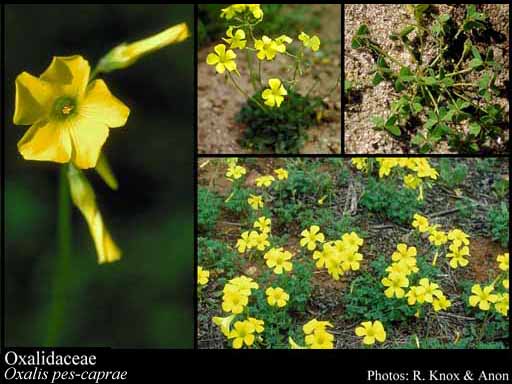- Reference
- Narr.Exped.Zaire p433 (1818)
- Name Status
- Current

Scientific Description
Common name. Oxalis Family.
Habit and leaf form. Herbs. Switch-plants (sometimes), or ‘normal’ plants; occasionally phyllodineous. Leaves well developed (usually), or much reduced. Perennial; plants with a basal concentration of leaves, or with neither basal nor terminal concentrations of leaves; rhizomatous, or tuberous. Hydrophytic to helophytic, or mesophytic, or xerophytic; when hydrophytic, rooted. Leaves alternate; spiral; petiolate; non-sheathing; compound; unifoliolate, or ternate, or pinnate, or palmate. Leaflets often pulvinate (exhibiting ‘sleep movements’). Leaf blades pinnately veined. Leaves without stipules; without a persistent basal meristem. Vernation circinnate (usually), or not circinnate. Leaf anatomy. Hydathodes present (sometimes), or absent. Stem anatomy. Nodes tri-lacunar. Secondary thickening absent, or developing from a conventional cambial ring.
Reproductive type, pollination. Fertile flowers hermaphrodite. Unisexual flowers absent. Plants hermaphrodite (often with additional small cleistogamous flowers). Plants usually heterostylous (mostly tristylous).
Inflorescence and flower features. Flowers solitary, or aggregated in ‘inflorescences’; in cymes, in panicles, and in umbels. The terminal inflorescence unit cymose. Inflorescences axillary; cymes or ‘sub-umbellate’, often pedunculate. Flowers small to large; regular; 5 merous; cyclic; tetracyclic to pentacyclic. Free hypanthium absent. Hypogynous disk present, or absent. Perianth of chasmogamous flowers with distinct calyx and corolla; 10; 2 -whorled; isomerous. Calyx 5; 1 -whorled; polysepalous; imbricate; regular; persistent. Corolla 5 (often lacking in cleistogamous flowers); 1 -whorled; polypetalous (usually), or gamopetalous (sometimes slightly connate basally); contorted (usually), or imbricate; regular. Petals sometimes shortly clawed, or sessile. Androecium 10. Androecial members free of the perianth; all equal, or markedly unequal (the outer whorl usually with shorter filaments); coherent; 1 - adelphous (the filaments basally connate); 2 -whorled. Androecium exclusively of fertile stamens, or including staminodes. Staminodes when present, 5. Stamens 5, or 10; diplostemonous, or isomerous with the perianth; alternisepalous (the shorter, outer members opposite the petals), or oppositisepalous (when the outer members lack anthers). Anthers dorsifixed; dehiscing via longitudinal slits; introrse; tetrasporangiate. Gynoecium 5 carpelled. The pistil 5 celled. Carpels isomerous with the perianth. Gynoecium apocarpous to syncarpous; semicarpous to synovarious (the carpels more or less free in Eichleria, Biophytum); superior. Carpel (when semicarpous), capitate stylate. Placentation when carpels more or less free, marginal. Ovary plurilocular; usually syncarpous and 5 locular (the lobes opposite the petals). Styles 5; free. Stigmas dry type; papillate; Group II type. Placentation nearly always (i.e. when syncarpous) axile. Ovules 2–15 per locule (to ‘several’); pendulous; epitropous; arillate (often); anatropous, or hemianatropous.
Fruit and seed features. Fruit non-fleshy; when semi to apocarpous, an aggregate (e.g. Biophytum), or not an aggregate (usually); when syncarpous (i.e. usually) dehiscent; a capsule. Capsules loculicidal. Fruit often elastically dehiscent (involving their arilliform epidermis). Seeds usually copiously endospermic. Endosperm oily. Cotyledons 2. Embryo chlorophyllous (1/3); straight. Seedling. Germination phanerocotylar.
Physiology, biochemistry. Aluminium accumulation not found. Plants accumulating free oxalates. Photosynthetic pathway: C3 and CAM.
Geography, cytology, number of species. World distribution: cosmopolitan except for frigid regions, concentrated in the tropics and subtropics. X = (5-)7(-12). 875 species.